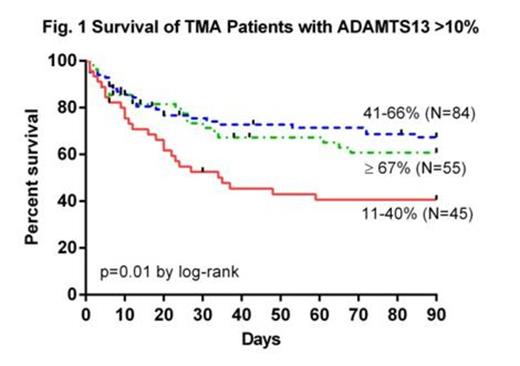Abstract
Introduction: The ADAMTS13 assay is routinely ordered as part of the work-up for thrombotic microangiopathies (TMAs). While severe deficiency of ADAMTS13 activity (≤10%) is specific for the diagnosis of idiopathic TTP and identifies a group of patients who respond well to treatment with therapeutic plasma exchange (TPE), the implications of mild-to-moderate deficiency (11-66%) remain unclear. This study aims to elucidate the presenting characteristics, clinical outcomes and diagnoses, and responses to TPE in TMA patients with non-critically low ADAMTS13 activity.
Methods: Two hundred-fifty two adult TMA patients from 3 large academic medical centers over a 10-year period were identified based on the presence of microangiopathic hemolytic anemia (schistocytes on smear, platelets <150,000/μL) and available ADAMTS13 results. Sixty-eight patients with ADAMTS13 ≤10% were excluded from the current analysis. Three cohorts were identified from the remaining 184 patients based on their ADAMTS13 activity level: 45 moderately deficient (11-40%), 84 mildly deficient (41-66%), and 55 non-deficient (≥67%). The ANOVA and chi-square tests were used for intergroup comparisons. Kaplan-Meier curves with log-rank analysis were used to assess survival differences where day 0 was defined as the day ADAMTS13 assay was sent.
Results: With the exception of younger age in the non-deficient group, the 3 cohorts were similar with respect to gender and ethnicity, presenting signs and symptoms, clinical history and laboratory values (Table 1). Whereas the frequency of secondary TMA attributable to drugs, malignancy, hypertension, hemolytic-uremic syndrome (HUS), and autoimmune disease was not different across these three cohorts, patients with moderate reduction in ADAMTS13 activity were more likely to have disseminated intravascular coagulation (DIC) and sepsis compared to the mildly- and non-deficient cohorts (p=0.001). Additionally, the moderately deficient cohort had slower recovery of platelet count by day 4 (p=0.043) and significantly lower 90-day survival (Figure 1, p=0.01 by log-rank). The role of TPE in patients with moderate ADAMTS13 deficiency was evaluated. TPE was performed in 10 of 45 patients (22%). Presenting features among these 10 patients were not significantly different from the 33 patients (73%) who did not receive TPE (2 patients receiving <3 treatments were excluded). The 90-day survival between these two subgroups was not significantly different (Figure 2, p=0.48 by log-rank).
Conclusions: Moderate ADAMTS13 deficiency (11-40%) in patients with TMA is more frequently associated with an underlying diagnosis of DIC and sepsis and portends slower recovery as well as worse survival. A modest reduction of ADAMTS13 activity may be a result of disease manifestation rather than the cause. Therefore, therapy directed at the underlying disease processes may lead to better outcomes than routine plasma exchange for these patients.
No relevant conflicts of interest to declare.
Author notes
Asterisk with author names denotes non-ASH members.




This feature is available to Subscribers Only
Sign In or Create an Account Close Modal